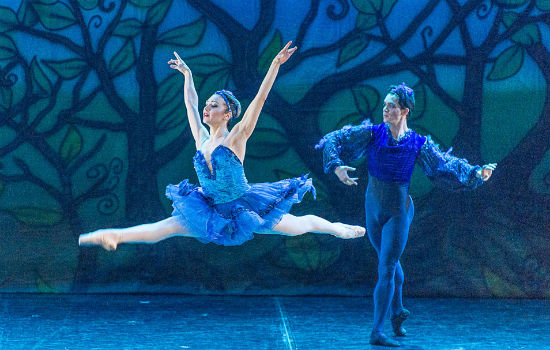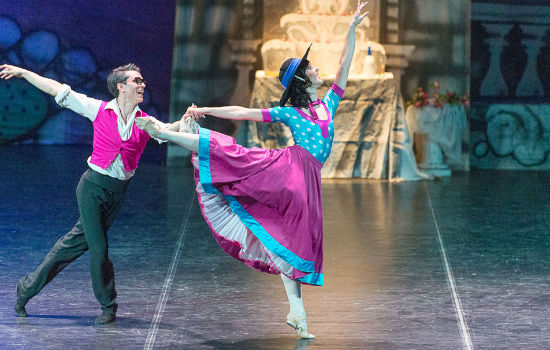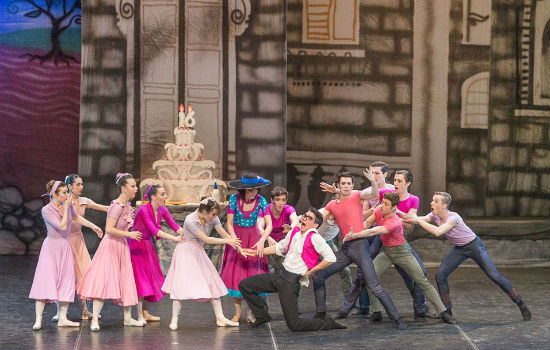Out of all the art forms, ballet holds a special place in my heart. I remember my parents taking me to a variety of symphonic, opera and theatre performances. As a child I played with makeup and props backstage; I enjoyed plays and concerts in the audience and I could go to the extent of attending the same theatre play dozens of times, eventually memorising all the lines.
At other times I was less interested or even slept on my father’s lap through the concert. But the ballet always fascinated me, keeping my eyes wide open, and I would dream about it after I returned home.
As much as all performing arts have their own charm, in classical ballet I find a unique kind of magic. The magic unveils with the raising of the curtain, puts a spell on the audience and keeps it breathless until the last bar is played by the orchestra and the last tutu skirt disappears behind the falling curtain.
Just like every magic trick, there is a moment when something very ordinary is transformed into something extraordinary. A large team of amazing artists – the choreographer, the dancers, the composer, the orchestra, the conductor, the scenographer, the costume designer, the technicians, etc – make this magic possible.

The Sleeping Beauty ballet by the Italian Balletto del Sud company at the Cairo Opera House, February 2018. (Photo: Bassam Al Zoghby)
This kind of magic came to the Cairo Opera House with the Italian company Balletto del Sud which between 6 and 8 February performed The Sleeping Beauty, a ballet in two acts directed and choreographed by the troupe’s founder and one of the best known Italian choreographers Fredy Franzutti.
Founded in 1995, in Lecce, a historic city in the south of Italy, the company's repertoire boasts over 30 ballets, including The Nutcracker, Swan Lake, Sheherazade, The Firebird, Romeo and Juliet, Carmen, and The Four Seasons. The company stages 80 evening ballets annually, many of which travel across Italy and internationally.
The original version of The Sleeping Beauty to Tchaikovsky’s music is choreographed by Marius Petipa (1890). It is based on the timeless story "La Belle au bois dormant" (The Sleeping Beauty) by the French writer Charles Perrault (1628 -1703). The story by Perrault is in turn inspired by the fable Sun, Moon, and Talia. The latter was written down by Giambattista Basile (1575-1621), an Italian poet who collected and documented folk tales from the Italy’s south.

Aurora (Nuria Salado Fustè) and Ernesto (Tsetso Ivanov) in The Sleeping Beauty ballet by the Italian Balletto del Sud company at the Cairo Opera House, February 2018. (Photo: Bassam Al Zoghby)
In his version of the ballet, Franzutti brings in many details from Basile’s version of the fairy tale, including setting the story back in the southern Italy. Equally, Aurora is a lovely Mediterranean girl whose terrible destiny is predicted by the wicked fairy Carabosse, in fact an old and scary sorceress. A kiss of love from Ernesto, the prince-anthropologist and a bit of magic from Lily’s Gypsy awaken the girl from her century-long sleep.
Nuria Salado Fustè as Aurora captured the filigree finesse of the heroine, while Tsetso Ivanov as Ernesto interwove the strong masculinity with the character’s amiable and noble nature.
But this is not all. Playing further with Basile and Perraut, Franzutti adds his own unique character to the story, whereby – and here comes the spoiler – the sorceress is forgiven, invited to the wedding and becomes the one to catch the bouquet tossed by Aurora.
The fairy Carabosse being performed by a man in disguise (Andrea Sirianni), a character originally created by the choreographer for the English dancer, choreographer and mime Lindsay Kemp, is an only seemingly simple but unique and effective idea, a move that opened the door to new interpretations of the meanings hidden in the iconic fairy tale. In fact Kemp (born 1938) and his “dream dance”, a form rich in inspiration braiding many dance forms, have influenced numerous choreographers and their works.

The fairy Carabosse (Andrea Sirianni) in The Sleeping Beauty ballet by the Italian Balletto del Sud company at the Cairo Opera House, February 2018. (Photo: Bassam Al Zoghby)
On the other hand, Franzutti’s Sleeping Beauty also includes many small choreographic puns. They all add a special flavour to the great dish, just enough to put a warm smile on the viewers’ faces without falling into the trap of needless exaggeration. On the thematic level, fun, love and joy add a lot of warmth to the story and on leaving the hall, the audience’s hearts are filled with compassion and hope, both being intense realisations to be experienced by the spectators.
Equally interesting is the development of Roberto (Carlos Montalvan), Aurora’s father, and Silvia (Beatrice Batolomei), the mother. We witness their transformation from their days of youth and infatuation with one another, the pregnancy, their care for Aurora as a small girl and fun with the child enjoyed by her father, then the parents’ maturity and finally their old age. Again, the human emotions are all there, evolving with time, facing and against all odds of the dramaturgy, captured in movement.
Since its premiere in Lecce in 2000, Italy, the ballet has garnered dozens of thrilling reviews from critics and admiration from the audience in Italy and internationally. This not without reason. The enjoyable dramaturgy, the captivating setting and lively characterisation of the protagonists and of the supporting characters, each being very distinctive, are all ingredients of a success potion. This is topped with beautiful solos by the dancers, pas de deux and, particularly well drawn by Francesco Palma, the group scenes including those depicting the festivities.

Roberto (Carlos Montalvan), Aurora’s father, and Silvia (Beatrice Batolomei), Aurora's mother, in The Sleeping Beauty ballet by the Italian Balletto del Sud company at the Cairo Opera House, February 2018. (Photo: Bassam Al Zoghby)
Franzutti’s work is cutting-edge without being forceful or presumptuous. Enveloped in a classical jacket, it welcomes time in its unfolding, bringing with it the newer trends in dance, from ballroom to modern, the 1970s formats, a spoon of rock’n’roll and a touch of acrobatics. At the same time, while respecting the core aesthetics of the classical ballet, Franzutti’s sense of creativity and well-balanced humour is apparent in major dramaturgical lines as well as the details.
The gentle playfulness reminded me of another classical performance that came to Egypt back in early 2010, with the Solisti Veneti Orchestra, a first-rate, small Italian ensemble specialising in music from the Baroque and early Classical periods.
Though completely different in the material presented, the Solisti Veneti added a few twists to the otherwise well-known compositions, enjoying the music and projecting new emotions onto the audience. As no matter how classical the material is, how many centuries stand between us and the composer, or how old the fairy tale is conceived, the creativity allows the artists to extract a new spirit and new meanings from the material at hand, just as Solisti Veneti did with their classical repertoire, or Franzutti with The Sleeping Beauty. This formula keeps art alive.

The Sleeping Beauty ballet by the Italian Balletto del Sud company at the Cairo Opera House, February 2018. (Photo: Bassam Al Zoghby)
In brief, for almost three hours, a duration that is hardly acceptable by today’s standards, especially in Egypt, we witnessed art in its purest form. The Sleeping Beauty is living proof that if the performance is rich in vision and execution, even the most bored or disgruntled will be captivated by it. This is the magic of ballet and art in general. If we were to ask for anything in this ballet it would be a live orchestra, since unfortunately in Egypt, Franzutti’s Sleeping Beauty was performed to recorded music.
Ballet is not only about the tutu skirts, every girl’s dream; it is not only the perfectly executed pirouettes or tours en l’air, the jetés or the entrechats, but it is the whole atmosphere in which those and many other movements serve to tell a story in the most artistic, creative, aesthetic and as such, breathtaking way. It is also the scenography which in The Sleeping Beauty recreated the palace or nature, and when supported by good lighting allowed the characters to appear on stage or fused them into disappearance behind the transparent curtain.
This is the story of The Sleeping Beauty and its magic, as performed by the Balletto del Sud, probably one of the most memorable ballet performances presented to Egyptian audiences in the past years. Even without my inherent love of ballet, Franzutti’s Sleeping Beauty, the story and its execution would make me want to attend it time and time again, to savour its beauty ad infinitum, just as I used to as a young child.
Time to dream of The Sleeping Beauty now...

The wedding scene. The Sleeping Beauty ballet by the Italian Balletto del Sud company at the Cairo Opera House, February 2018. (Photo: Bassam Al Zoghby)
This article was first published in Al Ahram Weekly
For more arts and culture news and updates, follow Ahram Online Arts and Culture on Twitter at @AhramOnlineArts and on Facebook at Ahram Online: Arts & Culture
Short link: